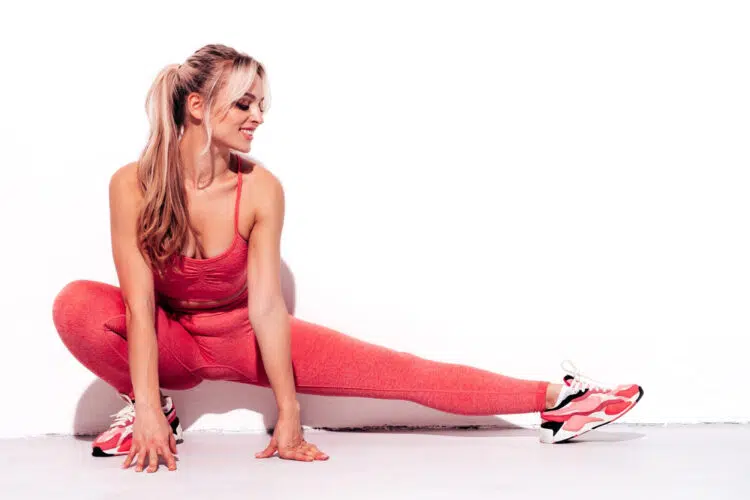Most people never start their transformation journey because they feel they cannot make the time to exercise.
One of the most common misconceptions people have about training is that the amount of time spent in the gym is directly proportional to the gains. Make no mistake, longer workouts are not always better.
Let’s face it: lengthy workouts can be a luxury many of us simply can’t afford.
This is where circuit workouts shine.
As a personal trainer with over 17 years of lifting experience, I have first-hand experience with the effectiveness of circuit training sessions. Not only are they incredibly time efficient, but they are also as effective as conventional workouts for improving cardiovascular health, shedding weight, and building muscle. (1)
In this article, I’ll take you over the benefits of full-body circuits and how to design them. I’ll also pull back the curtain on three of my super secret 20-minute circuit workouts for boosting cardiovascular health, weight loss, and hypertrophy that I’ve used to transform the physiques of hundreds of my clients.
Level Up Your Fitness: Join our 💪 strong community in Fitness Volt Newsletter. Get daily inspiration, expert-backed workouts, nutrition tips, the latest in strength sports, and the support you need to reach your goals. Subscribe for free!
What is Full-Body Circuit Training?
Full-body workouts are designed to maximize your results in minimal time. They usually follow the high-intensity interval training (HIIT) structure. It involves alternating between short periods of intense exercise and brief rest periods.
Full-body circuit training is an incredibly effective way to torch calories and build muscle and cardiovascular health. It also boosts your heart and metabolic rate, allowing you to burn calories throughout the day, even when you are not physically active.
Structure of Circuit Training
One of the best things about circuit training is that there is no fixed structure. This ensures that your muscles never get adapted to your training routine, helping you prevent strength and muscle plateaus.
Think of circuit workouts like a playlist. You can go in order or hit the shuffle button to alternate between random exercises.
Compound Movements vs. Isolation Exercises
Since we are only dealing with 20 minutes here, we want to get the best bang for our buck. But how do we do that, you ask? Through compound movements.
Multi-joint lifts allow you to target various muscles with a single exercise, maximizing muscle stimulation and growth potential. Compound exercises also facilitate the release of hormones like testosterone and growth hormone, which can take your gains to the next level. (2)
Customization is Key
Circuit workouts are highly versatile, meaning you can adapt them according to your training experience and goals.
Whether you want to lose weight, build muscle, or improve your cardiovascular conditioning, there is a circuit workout out there waiting for you. If a benchmark workout feels too easy or difficult, adjust the training volume and intensity until you check all the boxes.
Benefits of 20-Minute Full-Body Circuits
Here are the advantages of switching to full-body workouts:
Time Efficiency
Traditional workouts can last several hours, making them unsuitable for many lifters. Circuit workouts, on the other hand, pack a punch in a short period.
Make no mistake. These workouts aren’t about taking it slow or easy. Think of it like hopping onto a speed train and doing the same amount of work as you would in a conventional workout in 20 minutes flat.
Remember, you are doing something wrong if your heart isn’t pounding and your lungs aren’t burning by the end of a HIIT workout.
Increased Calorie Burn
Doing a ton of work in a short period significantly spikes your calorie expenditure. According to a comparative study published in the Journal of Strength and Conditioning Research, HIIT workouts can burn up to 30 percent more calories than conventional workouts of the same duration. (3)
It also leads to a phenomenon known as excess post-exercise oxygen consumption (EPOC), or the after-burn effect, meaning your body burns excessive calories even hours after your workout.
Muscle Building and Strength Gains
Although 20 minutes might feel like a short period, sticking to a 12-week HIIT routine can help you hit your muscle and strength gain goals. It is critical that you include a variety of exercises in your regime to ensure overall, balanced development.
Sticking to the same types of exercises for an extended period can lead to plateaus.
Improved Cardiovascular Health
Circuit training is one of the best ways to improve your heart health and lung capacity. The three 20-minute workouts listed in this article will help improve your endurance and lower your risk of heart disease and blood pressure.
That said, you must consult your healthcare provider before starting any new training or diet program, especially if you’re dealing with existing issues.
Enhanced Mood and Mental Clarity
An intense workout is known to increase endorphin production and release, which can help improve your mood, reduce stress, and boost energy levels.
Level Up Your Fitness: Join our 💪 strong community in Fitness Volt Newsletter. Get daily inspiration, expert-backed workouts, nutrition tips, the latest in strength sports, and the support you need to reach your goals. Subscribe for free!
Regular exercise can also help enhance cognitive function and mental clarity.
Convenience and Accessibility
Most circuit workouts are bodyweight routines, making them incredibly convenient and accessible. Since they usually last between 10 to 30 minutes, you can do these workouts anywhere and at any time, even when traveling.
Plus, it is incredibly easy to increase the training time as you gain more experience and need an additional challenge.
Three 20-Minute Circuits For Weight Loss, Muscle Gains, and Cardiovascular Health
Now that you know the science behind and benefits of 20-minute circuit workouts, it’s time to get down to business.
Switching to a 20-minute routine can feel intimidating as it involves fitting a lot of training in a very short period. I am here to simplify the entire process.
Given below are three circuits designed for varying goals:
Warm-Up
Before you begin the workout, you must spend five to 10 minutes warming up the target muscles to maximize your training performance and limit the risk of injury.
Research suggests that the ideal warm-up routine should primarily involve dynamic stretches like arm circles and leg swings. These help boost the blood flow to the target muscles, priming them for action. (4)
Circuit One: Cardiovascular Health
This workout is specifically designed to get your heart pumping and lungs working. It will boost your aerobic endurance and stamina, which can improve your training performance and daily functionality.
Do four rounds of this five-exercise circuit to complete your 20-minute workout:
| Exercise | Sets | Reps/Time | Rest |
| Jumping jacks | 3 | 30 seconds | 30 sec |
| High knees | 3 | 30 seconds | 30 sec |
| Butt kicks | 3 | 30 seconds | 30 sec |
| Mountain climbers | 3 | 30 seconds | 30 sec |
| Plank | 3 | 30 seconds | 30 sec |
Coach Tip: Maintain a high intensity throughout the workout to get the best bang for your buck. That said, you shouldn’t compromise your form, trying to go fast. Focus on your form and nail each rep.
Circuit Two: Weight Loss
This circuit workout comprises more physically intensive exercises to help torch those extra pounds. The weight loss circuit is designed to target all your muscle groups from different angles to maximize muscle stimulation and adaptations.
Perform three rounds of this circuit. Rest for one minute after completing each six-exercise round:
| Exercise | Reps/Time | Rest |
| Burpees | 30 seconds | 30 sec |
| Squat jumps | 30 seconds | 30 sec |
| Mountain climbers | 30 seconds | 30 sec |
| Push-ups | 30 seconds | 30 sec |
| Jump rope | 30 seconds | 30 sec |
| Russian twists | 30 seconds | 30 sec |
Coach Tip: Beginners can stick to bodyweight exercises, whereas more experienced lifters can add ankle weights to make the movements more challenging.
Circuit Three: Muscle Building
Contrary to what most people think, circuit workouts aren’t just for losing weight; they are just as effective for building muscle.
The following circuit focuses on compound exercises that target multiple muscle groups simultaneously. Prioritize maintaining a picture-perfect technique over lifting excessively heavy weights.
Complete four rounds of the following circuit:
| Exercise | Reps | Rest |
| Squats | 10-12 | 30 sec |
| Lunges | 10-12 | 30 sec |
| Push-ups | AMRAP | 30 sec |
| Bent-over rows | 10-12 | 30 sec |
| Plank | 30-60 seconds | 30 sec |
Coach Tip: Ensure a full range of motion (ROM) while performing these lifts for optimal muscle stimulation and growth.
Cool Down
Congratulations on completing these three intense 20-minute training sessions. However, the workout isn’t done as soon as you complete your final rep. Take five to 10 minutes after each workout to cool down.
Static stretches like the child’s pose and the Samson stretch are incredibly effective for flushing out the metabolites from the muscles and promoting recovery. They also help prevent soreness and improve overall flexibility and functionality.
Tips for Success During Full-Body Circuit Training
Keep the following factors in consideration for maximizing results:
- Progressive Overload: I highly recommend gradually increasing the training volume and intensity to make consistent progress. Sticking to the same programming for an extended period can lead you to a muscle and strength plateau.
- Proper Form: It is easy to chase heavier weights when you only have 30 seconds of working time for each exercise. However, you must resist the temptation and stick to the weights that you can lift with a picture-perfect technique. This maximizes adaptations while limiting injury risk.
- Nutrition and Recovery: Training is only 33.3 percent of the equation. You must also focus on your recovery and nutrition to achieve your physique transformation goals. Sleep for at least eight hours each night, and use this TDEE calculator to determine your daily calories and macro needs.
- Listen To Your Body: Discontinue an exercise if something feels weird or uncomfortable. Consult your doctor if you’re experiencing pain, and it doesn’t subside within a couple of days.
Conclusion
Most of us are juggling work, family, and social commitments, and somewhere in there, we have to find the time to hit the gym. Knowing that a workout might take you over an hour to complete, you are more likely to skip a training session.
The three circuit workouts listed in this article will help improve your cardiovascular stamina and boost weight loss and hypertrophy in 20 minutes flat. Like any other training program, discipline, consistency, and dedication are vital to maximizing results. Perform these workouts three to six times a week for eight to 12 weeks to achieve noticeable results.
If you have any questions about the 20-minute full-body circuit training routines explained in this article, post them in the comments below, and I’ll be happy to help!
References:
- Buch, A., Kis, O., Carmeli, E., Keinan-Boker, L., Berner, Y., Barer, Y., Shefer, G., Marcus, Y., & Stern, N. (2017). Circuit resistance training is an effective means to enhance muscle strength in older and middle-aged adults: A systematic review and meta-analysis. Aging research reviews, 37, 16–27.
- Craig, B. W., Brown, R., & Everhart, J. (1989). Effects of progressive resistance training on growth hormone and testosterone levels in young and elderly subjects. Mechanisms of aging and development, 49(2), 159–169.
- Falcone, P. H., Tai, C. Y., Carson, L. R., Joy, J. M., Mosman, M. M., McCann, T. R., Crona, K. P., Kim, M. P., & Moon, J. R. (2015). Caloric expenditure of aerobic, resistance, or combined high-intensity interval training using a hydraulic resistance system in healthy men. Journal of strength and conditioning research, 29(3), 779–785.
- Samson M, Button DC, Chaouachi A, Behm DG. Effects of dynamic and static stretching within general and activity-specific warm-up protocols. J Sports Sci Med. 2012 Jun 1;11(2):279-85. PMID: 24149201; PMCID: PMC3737866.














